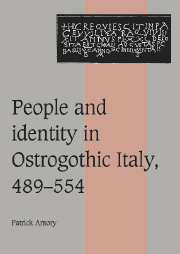Book contents
- Frontmatter
- Contents
- Preface
- List of rulers
- Terminology and vocabulary
- List of abbreviations
- Map of Ostrogothic Italy
- Introduction: Studying the barbarians in late antiquity
- 1 Ethnicity, ethnography and community in the fifth and sixth centuries
- 2 The Ravenna government and ethnographic ideology: from civilitas to bellicositas
- 3 Individual reactions to ideology I: names, language and profession
- 4 Complementary and competing ideals of community: Italy and the Roman Empire
- 5 Individual reactions to ideology II: soldiers, civilians and political allegiance
- 6 Catholic communities and Christian Empire
- 7 Individual reactions to ideology III: Catholics and Arians
- 8 The origin of the Goths and Balkan military culture
- Conclusion
- Appendix 1 The inquiry into Gundila's property: a translation and chronology
- Appendix 2 The Germanic culture construct
- Appendix 3 Archeological and toponymic research on Ostrogothic Italy
- Appendix 4 Dress, hairstyle and military customs
- Prosopographical Appendix: A prosopography of Goths in Italy, 489–554
- Bibliography
- Index
- Cambridge Studies in Medieval Life and Thought Fourth Series
1 - Ethnicity, ethnography and community in the fifth and sixth centuries
Published online by Cambridge University Press: 03 December 2009
- Frontmatter
- Contents
- Preface
- List of rulers
- Terminology and vocabulary
- List of abbreviations
- Map of Ostrogothic Italy
- Introduction: Studying the barbarians in late antiquity
- 1 Ethnicity, ethnography and community in the fifth and sixth centuries
- 2 The Ravenna government and ethnographic ideology: from civilitas to bellicositas
- 3 Individual reactions to ideology I: names, language and profession
- 4 Complementary and competing ideals of community: Italy and the Roman Empire
- 5 Individual reactions to ideology II: soldiers, civilians and political allegiance
- 6 Catholic communities and Christian Empire
- 7 Individual reactions to ideology III: Catholics and Arians
- 8 The origin of the Goths and Balkan military culture
- Conclusion
- Appendix 1 The inquiry into Gundila's property: a translation and chronology
- Appendix 2 The Germanic culture construct
- Appendix 3 Archeological and toponymic research on Ostrogothic Italy
- Appendix 4 Dress, hairstyle and military customs
- Prosopographical Appendix: A prosopography of Goths in Italy, 489–554
- Bibliography
- Index
- Cambridge Studies in Medieval Life and Thought Fourth Series
Summary
Fifth- and sixth-century use of classical ethnographic ideologies – in propaganda, literature, theology and art – created the Goths of Italy. This re-use of elements from the heritage of Mediterranean ethnographic culture “created” the Goths not only for us, for whom they so frequently seem a concrete and stable community or tribe, but also for men and women of the period, for whom distinct advantages or disadvantages accrued from accepting the label Goth at different times and in different places.
Ancient ethnographic description of barbarian groups such as the Goths need not always have described ethnicity. Ethnicity is not the only form of community in a society, or the necessary primary identity for an individual. He or she may belong to several different groups, the relative importance of which can shift according to the circumstance of the moment. These different communities within society attracted ethnographic description in late antiquity. A soldier in Italy in 510 could belong to the Catholic church, own tax-bearing property and speak the Latin language. As a soldier he could be called a “Goth” by the king, as a Latin-speaking taxpayer a “Roman,” as a member of the Catholic church and an inhabitant of Italy, a citizen of the imperium Christianum – or of the province of Lucani et Brutii and the episcopal see of Reggio. At different moments in his life, different labels would be of use to him or to the powers who chose to classify him in such ways.
- Type
- Chapter
- Information
- People and Identity in Ostrogothic Italy, 489–554 , pp. 13 - 42Publisher: Cambridge University PressPrint publication year: 1997



